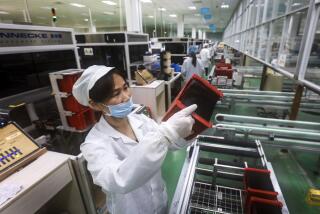Stimulating Japan’s Economy, Not Tariffs, Will Open Up Its Markets
- Share via
Japan consumes and invests domestically less than it produces by an amount roughly equal to 3% of its gross domestic product. The United States consumes and invests more than it produces by about 1.75% of its GDP. As long as these imbalances persist, the United States will run a deficit, and Japan a surplus, in their international current accounts. Getting “tough” over Japan’s resistance to importing cars and auto parts may make U.S. policy-makers feel good, but will not alter these imbalances.
This is not to condone Japan’s mercantilism and its anachronistic non-tariff and distribution impediments to opening up its domestic markets to imports of cars, auto parts, telecommunications, medical equipment, financial services and government procurement. Nor does this indictment gainsay the fact that Japan has made efforts and progress--however slow and insufficient--toward opening its markets to imports.
But if either the United States or Japan truly wants to alter their respective and opposite trade imbalances, there are better and worse ways of going about it. Imposing 100% tariffs on Japanese luxury-car exports to the United States as a means of inducing Tokyo to increase U.S. exports of auto parts to Japan is not among the better ways.
The Japanese economy is suffering from a protracted recession. During the past four years, Japan’s GDP has hovered between slightly positive and slightly negative growth. Unemployment, although low by U.S. standards, is at its highest level in 40 years--and rising. Corporate profits in many industrial sectors have been low; capital spending continues to fall. Japan’s banking system has amassed an enormous volume of bad debts, estimated between 21 trillion yen ($240 billion) and 100 trillion yen ($1.2 trillion). That is several times larger than the U.S. savings-and-loan fiasco in the 1980s. For the first time in Japan’s postwar history, new lending has, since mid-’94, been below the previous year’s level, and has continued to decline.
If Japan yields to the U.S. sanctions threat--”buy my cars, or else,” as The Economist describes it--the additional imports of cars and auto parts would add further deflationary pressure to the economy’s already protracted recession. Quite probably, Japanese imports of goods and services, other than cars, would decrease, resulting in minimal change in the two countries’ trade imbalances.
There is a better way, one that would seek to redress Japan’s chronic current-account surplus--the symptom--by remedying its domestic macroeconomic imbalance--the cause. It has two parts:
* A large expansion of Japan’s public investment--to $300 billion--for repair and replacement of the enormous damage inflicted by the January Kobe earthquake, to be financed by issuing general government revenue bonds;
* Assuring that at least half this amount is open to genuinely fair competitive bidding by foreign engineering and construction firms.
Such a large injection of public investment spending would provide for reconstruction of the major sections of the Hanshin Expressway that collapsed in the earthquake, as well as repair or replacement of the road and rail network, water mains, port facilities, power-generating and distribution structures, telecommunications, and commercial and residential structures. The result would be a timely stimulus to a demand-limited, deflationary economy.
Because the Japanese economy has been operating at about 80% of capacity, the resulting boost in demand would generate increased output without inflation. If this incremental public investment were spread over, say, three years, Japan’s annual growth rate could be increased by about 2% above its anemic rates of the past four years, and its imports from the United States and elsewhere would increase accordingly.
Furthermore, opening at least half the additional investment to genuinely fair, competitive bidding by foreign firms would result in large savings for Japanese taxpayers and bondholders. Construction costs of major U.S. firms, like Bechtel, and Fluor, and Korean ones like Hyundai, are between one-quarter and one-fifth the comparable costs of Japanese construction and engineering firms. If half the repair and reconstruction projects were awarded to foreign bidders, Japan would save more than $100 billion.
In turn, these financial savings, by increasing the yen earnings of foreigners, would reduce Japan’s current-account surplus, as well as the U.S. current-account deficit, and would cap or reverse the excessive climb in the value of the yen in foreign-exchange markets--which is a source of concern to Japanese exporters and an embarrassment to Japan’s central bankers. Finally, by demonstrating flexibility and openness to cooperation with the outside world, Japan would measurably enhance its global structure, as well as seize the high ground in its protracted Framework talks with the United States.
To be sure, this scenario will be extremely difficult to realize. To seize the opportunity presented by the tragedy of the Kobe earthquake requires a rare combination of leadership by a frail Japanese government, flexibility by the powerful Japanese economic bureaucracy and pressure by an aroused and critical Japanese public, as well as by the United States. Unlike the application of sanctions proposed by the Administration, U.S. pressure in this domain would command powerful and extensive support from the rest of the international community.
More to Read
Inside the business of entertainment
The Wide Shot brings you news, analysis and insights on everything from streaming wars to production — and what it all means for the future.
You may occasionally receive promotional content from the Los Angeles Times.










